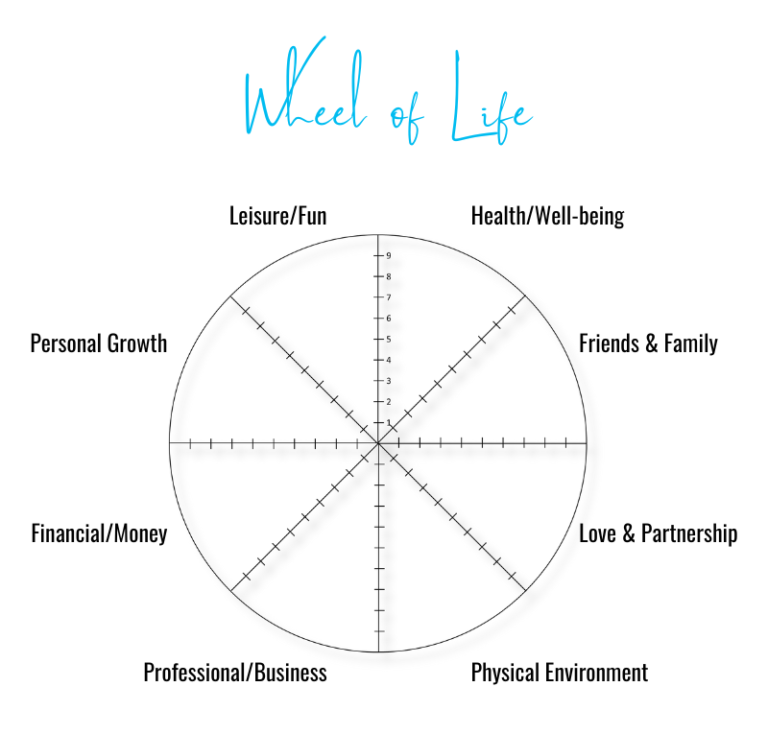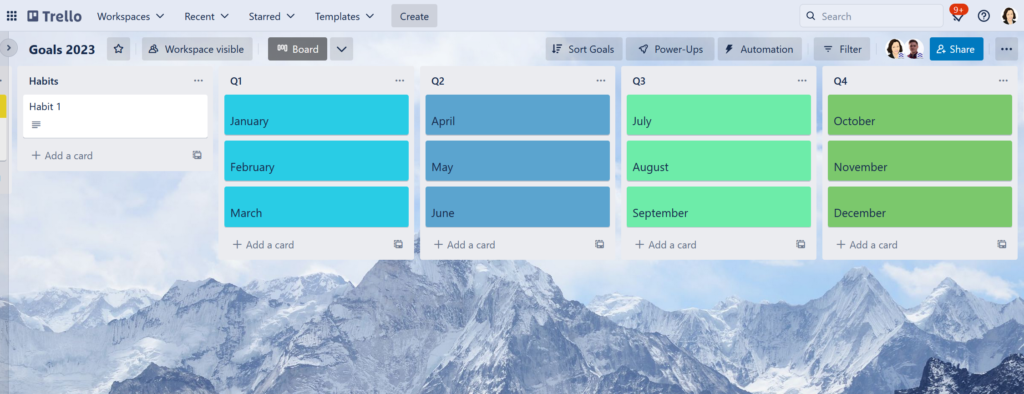This article is part of my Systems for Success trilogy:
- How to look back over your year (without getting lost in it)
- How to Set Goals for the New Year (and take your resolutions past January)
- The magic system I use to follow through on my goals: How to accomplish all your goals (and 10x your productivity this year)
As the year draws to a close, many of us start to think of goals for the year ahead.
There are plenty of methods out there for goal setting, both at a personal and professional level; having gained a reputation for setting (and achieving) goals, many people have asked for mine. In this post I take you step by step through the system I use to set my yearly goals in a way that has transformed my productivity and progress. If you struggle to make your New Year’s Resolutions into realities, or simply want to try something new, why not give it a go?
There’s nothing complicated about my system – all you need is a stack of post-it notes (feel free to substitute with stray pieces of paper, digital options, or anything else, but there’s something about the small post-it notes that really works for me), a pen, and a bit of time. Coffee cup, a big surface to take over and partner are optional – I like to do my goal-setting for the year as a joint exercise with my husband but it also works well solo.
I normally do my end of year evaluation on December 31st, then move on to goal setting the first weekend of January. I find that skipping that slump created by the celebrations, recovery, and getting back to work sets me well on the path to pursuing, planning in and achieving my goals.
The first weekend in January, I set aside a significant chunk of time, anywhere from an hour and a half to three or four hours (depending on how much planning I want to do) and get to work.
Before I take you through my system, please be aware that I take a bit of a maximalist approach to goal setting. I like mixing and matching goals of different types, areas and sizes, and so I don’t subscribe to Buffett’s 5/25 rule.
If you’re not familiar with it, the idea is to define 30 goals, and prioritize them in two groups – Group A contains the top 5 goals that you will commit to, and Group B the next 25, which you will avoid in order to ensure you’re focusing on your top priority goals. If you want to learn more about it (and get a few excellent productivity tips while you’re at it) Robbie Swale covers it in 15 Ways to Transform Your Relationship to Time, Get More Done and Feel Better While You Do It.
While this is a worthwhile approach, I prefer the flexibility my system affords me and the ability to make progress on all areas of my life if that is my aim. Which is not to say I try to do everything at once! If you want to learn more about my method, read on. You can also download the companion printable below:
Printable Download
Part 1: Brainstorming
To start, grab your stack of post-it notes and a pen, set a timer (I’d start with 30 minutes), and commit to writing down goals, desires or wants on them for the allotted time, with no filters – just write down as many as you can. Do not restrict yourself to goals you can accomplish in the next year – just note down as many goals as your unconstrained mind can come up with. Remember that habits you want to establish or qualities you want to develop are also goals worthy of being added to your list.
When you think you’ve run dry, challenge yourself to note down 5 more.
Once you’ve run out, the Wheel of Life Exercise can help. You may already be familiar with it, since it’s very common in coaching, and you’ll already have done most of the work if you also followed my Year End Evaluation guide. I often recommend it, since it’s a powerful tool for self-diagnosis and exploration.

The wheel is divided into eight areas that are key to your life, which you then use to evaluate how satisfied, on a scale of 1-10, you are with that particular area (10 being extremely satisfied, and 1 couldn’t be worse). Don’t just assign a number – noting down the reasons for that evaluation truly helps.
You can see the main categories below (and feel free to grab the printable here) but you can also edit it and remove any irrelevant ones, or add any that make more sense for your life, such as creativity, mental state, productivity, social life, spiritual growth, attitude, etc.
- Leisure/Fun
- Health/Well-being
- Friends & Family
- Love & Partnership
- Physical Environment
- Professional/Business
- Financial/Money
- Personal Growth
Once you’ve spent some time on each category, it’s time to think about how you would improve each of them. What would it take to move up one point? How could you achieve it? Add those to new post-it notes (don’t worry if you think you’ve already written down something similar during the brainstorm – the time to clean up and consolidate will come later).
Now that you’ve completed the brainstorming, and evaluated your wheel of life and added corresponding goals, make sure you also write down any goals you’ve accumulated over the year (for example, if you’ve set a specific goal at work you’ll want to make sure it’s in one of those post-it notes). If you’ve completed the end of year evaluation, you will also have identified some goals there based on the things you’ve accomplished this year, the things that made you feel inspired and energized, and from those that brought you down or slowed your progress. Make sure those are also added to your post-it notes.
Part 2: Consolidation
Once you have all your post-it notes ready, start grouping them by theme into clusters (for example, “Have a better relationship with my sibling”, “Host friends every month” and “Visit family more frequently” may all belong in the same cluster around improving your relationships). When you do this, you’ll probably find some repeating goals, especially if you’re doing this exercise with a partner – just remove any duplicates to keep your working area clear.
Feel free to name the clusters as they come up if that helps you better understand them. As you group them, you may find some reflect different aspects of the same goal. Now is the time to figure out whether you need to rewrite any of them to better express your objective.
You can also align them to the areas on your Wheel of Life to help you visualize which areas have a larger concentration of goals. It’s sometimes useful to ask yourself why that is – for example, it may be that those areas with lower scores have the most goals to help bring up your satisfaction in them, or that those with higher scores hog all the goals because those are areas you’re more passionate or comfortable in.
Once you have your clusters ready, it’s time to start categorizing them. I like to categorize them according to effort (is this a big, medium or small project or goal?) and timeline (is this a short-term, medium-term or long-term goal?). You can use highlighters of different colours for this, or simply mark them as B (big), M (medium) or S (small), and LT (long term), MT (medium term) or ST (short term).
Once you’ve classified them all, you may want to review all your long and medium term goals and see whether you need shorter term goals to help you achieve them. For example, if your long-term goal is to move to Spain, you may want to make sure you have smaller goals that feed into it, like learning Spanish, travelling the country to find which areas you like best, obtaining certificates that will help you find work when you move, etc. You can grab my 3 Powerful Questions for interrogating long-term goals to help you in this.
Part 3: Prioritization
Now that you have your goals clustered and categorized, it’s time to prioritize them. You probably have a lengthy list to contend with, and they won’t all fit into a year – that’s ok. We’re going to use a couple of tools to find those you will tackle this year, and the remainder can go into your backlog for next year or in case you end up having more bandwith than expected. I find that sometimes I need to pull goals from the backlog and move some to it as the year progresses, as circumstances change, and having them handy makes that process a lot easier.
The Eisenhower Matrix (or Urgent-Important Matrix) helps you prioritize goals by urgency and importance. You may be familiar with it from productivity practices, and when used to prioritize tasks it also suggests we designate them as Delegate, Do, Plan or Delete, but that part is not relevant for this goal assessment.
Simply draw a grid (or assign it to the corners of your coffee table, if that’s your canvas) with importance on the vertical axis and urgency on the horizontal axis, and place the goals accordingly on the grid. If you prefer, you can instead use an Impact-Effort Matrix, but I find urgency can be more helpful when planning out your goals so it’s the one I tend to use.

Either way, when assessing importance I tend to use two definitions of “importance” – one is based on my level of excitement or commitment to the goal, of how relevant it is for my life and happiness; the other, on whether it’s important by virtue of being necessary for a larger, more important goal. Following that rule, for example, imparting a guest lecture at a University could be an important goal because it’s something exciting that fulfils me and furthers my career; obtaining a visa would be important as a prerequisite step to moving countries.
If you’re carrying out this exercise with someone else there may need to be some discussion on how the goals are placed on the grid – don’t shy away, that’s a great opportunity to further discuss the goals and how they fit in with your values, goals and priorities.
Once you have them visually placed, you may find selecting the goals you want to carry into the New Year is an easy task. But if you’re not sure whether you’re allocating an achievable amount of goals (without veering into burnout!), then step 4 (planning) can help.
Part 4: Planning
Having a list of goals (even prioritized ones) can easily become a “New Year’s Resolution” of the kind that quickly languishes in January and is a distant memory in February. The key to actually achieving your goals is planning – the thing that turns dreams into goals and goals into actions. I’m not talking about weekly planning (although I’m a big fan of that and will be covering it in later posts) but about generally planning out your goals into the year.
At this point I normally move my post-it notes to Trello, where I can use tags to identify them as Long/Medium/Short term, and Big/Medium/Small. That also allows me to easily move them between the backlog and different months or quarters, and I can add more information or dates as I go. But you can still do this with pen and paper if you’d like. If you want you can also steal my Goal management Trello board (complete with automations that I’ll cover in my next post). Simply open it and copy it for yourself so you’re not starting from scratch.
I find the easiest way to plan is to divide my goals into two categories – Habits and Projects. They’re fairly self-explanatory, but habits are routines I want to build into my life (for example, having a set bedtime routine, exercise routine, or a specific mindset) while goals or projects are more time-bound and normally are not continuous (for example, developing my website, obtaining a promotion at work, or organizing a trip).
From the habits column, I pick my top priority and top urgency habits and try to keep it to around 5 habits for the year, although I have managed up to 11 in one year somewhat reliably. Try to be honest with yourself and keep it manageable – if you master them faster than expected, you can always pull others from your backlog when you have the bandwidth.
At this stage, you’ll want to make sure your habit is defined in a way that helps you achieve it, and write down how you plan to evaluate success – think: how will you know you’ve accomplished this goal? For example, “Read more” is a bit vague. What kind of reading counts? Will you be happy if you read two books where last year you read one? You will have, technically, “read more”. It also doesn’t tell you how you are going to achieve “reading more”, which makes it a lot harder to put to practice. But you can turn this into a habit goal by getting specific, for example, defining it as “read everyday while drinking my breakfast coffee and for half an hour before bed”; “read the news every morning on the way to work”, “read one chapter every day”, or “spend an hour reading every Saturday morning”.
From the Projects column, I look at my top priority and urgency goals and start assigning them to the quarters in the year (Q1 Jan-Mar, Q2 Apr-Jun, Q3 Jul-Sept, Q4 Oct-Dec). It helps to also put in anything that will be a significant drain or constraint on your time as well – for example, Q4 usually contains Christmas preparations and Holidays for me, since that makes the whole of December pretty much an arid land for projects. Using this method prevents over-stuffing of goals into your year, which quickly leads to lack of motivation and disillusionment when you inevitably fail or burn out.
Once you feel you have a good amount of goals assigned under each quarter, review your remaining goals. Are they ok to go straight to your backlog? Do you need to revise your year and make any adjustments?
You can take it a step further, if you want, and assign the goals to specific months. I find that keeping it at the quarterly level is more useful since my system includes monthly and quarterly reviews when I can better plan when the goal is closer, which lends it a bit more flexibility.
Assigning them into quarters makes it easier to prioritize your efforts within the year – you can better plan (and maintain your momentum) when you have this narrower focus. As you accumulate wins over time future goals feel easier to achieve, and you’re more likely to stick with them supported by the success you’ve already achieved.
As with habits, you’ll want to define a bit more what the project means, how you will evaluate success and, for those you are starting immediately, how you will go about it. You can explore how to turn goals into actionable steps in How to easily set life goals (and accomplish them!) – Creating Personal Branding goals.
If you’ve followed this guide you now hopefully have a list of goals (personal, professional and everything in between) to tackle next year. Wishing you the best of luck in your endeavours, and if you have any questions or suggestions please drop them below!
And if you want to learn more about how I manage these goals throughout the year (and how you can steal the same system), stay tuned for my next post.






No comment yet, add your voice below!